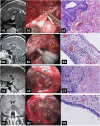A novel endoscopic classification for craniopharyngioma based on its origin
- PMID: 29977006
- PMCID: PMC6033946
- DOI: 10.1038/s41598-018-28282-4
A novel endoscopic classification for craniopharyngioma based on its origin
Abstract
Endoscopic endonasal approach for craniopharyngioma (CP) resection provides a wide view and direct observation of hypothalamus and origin of tumor. Under endoscopy, 92 CPs were classified into 2 types: Peripheral and Central, according to its relation to pituitary stalk. Peripheral type was further divided into 3 subtypes: Hypothalamic stalk, Suprasellar stalk and Intrasellar stalk CP, according to the different origin site along hypothalamus-pituitary axis. Peripheral type arisen from the stalk but expanded and grown laterally in an exophytic pattern, accounting for 71.7% of all CPs, preservation rate of stalk was higher (76.0%). Central type grew within and along pituitary stalk and located strictly in the midline. The pituitary stalk was hardly preserved (only15.4%). Hypothalamic stalk CPs (n = 36, 54.6%) developed from the junction of hypothalamus and stalk, hypothalamus damage was found in all of this subtype after surgery. Suprasellar stalk CPs (n = 14, 21.2%) originated from the lower portion of stalk and displaced hypothalamus upward rather than infiltrated it. Intrasellar stalk CPs (n = 16, 24.2%) arose from the subdiaphragma portion of the stalk, with less hypothalamus damage. Recoginzing the origin of CP is helpful to understand its growth pattern and relation to hypothalamus, which is critical in planning the most appropriate surgical approach and degree of excision.
Conflict of interest statement
The authors declare no competing interests.
Figures













Similar articles
-
Hypothalamic injury patterns after resection of craniopharyngiomas and correlation to tumor origin: A study based on endoscopic observation.Cancer Med. 2020 Dec;9(23):8950-8961. doi: 10.1002/cam4.3589. Epub 2020 Nov 3. Cancer Med. 2020. PMID: 33141521 Free PMC article.
-
Preoperative Assessment of Craniopharyngioma Adherence: Magnetic Resonance Imaging Findings Correlated with the Severity of Tumor Attachment to the Hypothalamus.World Neurosurg. 2018 Feb;110:e404-e426. doi: 10.1016/j.wneu.2017.11.012. Epub 2017 Nov 11. World Neurosurg. 2018. PMID: 29138072
-
Growth patterns of craniopharyngiomas: clinical analysis of 226 patients.J Neurosurg Pediatr. 2016 Apr;17(4):418-33. doi: 10.3171/2015.7.PEDS14449. Epub 2015 Dec 4. J Neurosurg Pediatr. 2016. PMID: 26636252
-
Craniopharyngioma treatment: an updated summary of important clinicopathological concepts.Expert Rev Endocrinol Metab. 2020 Jul;15(4):261-282. doi: 10.1080/17446651.2020.1770081. Expert Rev Endocrinol Metab. 2020. PMID: 32615875 Review.
-
[Modern concepts of topographic-anatomical classification of craniopharyngiomas: literature review].Zh Vopr Neirokhir Im N N Burdenko. 2024;88(5):110-117. doi: 10.17116/neiro202488051110. Zh Vopr Neirokhir Im N N Burdenko. 2024. PMID: 39422691 Review. Russian.
Cited by
-
Correlations between the expression of molecules in the TGF-β signaling pathway and clinical factors in adamantinomatous craniopharyngiomas.Front Endocrinol (Lausanne). 2023 Oct 3;14:1167776. doi: 10.3389/fendo.2023.1167776. eCollection 2023. Front Endocrinol (Lausanne). 2023. PMID: 37854185 Free PMC article.
-
"One-and-a-Half" Interdural Transcavernous Pituitary Transposition/Rotation for Protection of Hypophyseal Portal System in Adult Peripheral Retroinfundibular Craniopharyngioma.Oper Neurosurg. 2024 Jul 1;27(1):72-85. doi: 10.1227/ons.0000000000001067. Epub 2024 Mar 7. Oper Neurosurg. 2024. PMID: 38451095 Free PMC article.
-
Hypothalamic injury patterns after resection of craniopharyngiomas and correlation to tumor origin: A study based on endoscopic observation.Cancer Med. 2020 Dec;9(23):8950-8961. doi: 10.1002/cam4.3589. Epub 2020 Nov 3. Cancer Med. 2020. PMID: 33141521 Free PMC article.
-
Gross-total resection of a suprasellar with recurrent cerebellopontine angle region craniopharyngioma by endoscopic far-lateral supracerebellar infratentorial approach: illustrative case.J Neurosurg Case Lessons. 2022 Aug 15;4(7):CASE22166. doi: 10.3171/CASE22166. Print 2022 Aug 15. J Neurosurg Case Lessons. 2022. PMID: 36088552 Free PMC article.
-
Approach selection and outcomes of craniopharyngioma resection: a single-institute study.Neurosurg Rev. 2021 Jun;44(3):1737-1746. doi: 10.1007/s10143-020-01370-8. Epub 2020 Aug 22. Neurosurg Rev. 2021. PMID: 32827306
References
MeSH terms
LinkOut - more resources
Full Text Sources
Other Literature Sources
Medical
Miscellaneous

